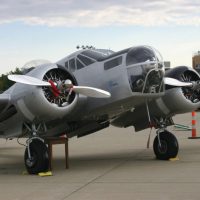During World War II aviation firmly established itself as a critical component of modern warfare, from the Battle of Britain in the early stages to the great aircraft carrier battles between American and Japanese Pacific fleets and the final delivery of nuclear weapons. The development of civil aviation stagnated until peace could be restored, and in the combatant countries, many existing civilian aircraft were pressed into military service. However military technologies developed during the war would revolutionize postwar aviation. In particular, the widespread construction of aerodromes with serviceable runways would provide the basis for a postwar move of long-range passenger flights from flying boats to land planes.
Beech SNB-1 “Kansan”
The Beech SNB-1 is a training variant of the Beech D-18. The USN SNB-1 is a glass-nosed, C-series aircraft that were built for bombardier, gunnery, and other training requirements during … Read more
Hawker Hurricane Mk. XII
The Hawker Hurricane is a British single-seat fighter aircraft of the 1930s–40s designed and predominantly built by Hawker Aircraft Ltd. for service with the Royal Air Force (RAF). It was … Read more
Grumman FM-2 Wildcat
Designated the F4F, its first flight took place in September of 1937. Fifty-four fixed-wing aircraft were ordered in 1939, and in 1940, the Navy decided that all future aircraft were to be built with folding wings. The French ordered 100 aircraft before the war broke out, but when the Germans invaded and France fell, the British took over the deliveries, renaming it the Martlet.
Curtiss P-40N “Warhawk”
The Curtiss P-40 Warhawk is an American single-engined, single-seat, all-metal fighter and ground-attack aircraft that first flew in 1938. The P-40 design was a modification of the previous Curtiss P-36 … Read more
Martin B-26 Marauder
The Martin B-26 Marauder was an American World War II twin-engined medium bomber built by the Glenn L. Martin Company from 1941 to 1945. First used in the Pacific Theater in early 1942, it was also used in the Mediterranean Theater and in Western Europe.
Not to be confused with the Douglas A-26 Invader, later designated B-26.
North American P-51K “Mustang” – NX79161
One of the most famous of all WWII aircraft, the North American P-51 Mustang was an American long-range, single-seat fighter and fighter-bomber used during World War II, the Korean War and other conflicts. The “K” model was a Dallas-built version of the P-51D. After World War II, it was exported to various countries including China, where it served in the Chinese Nationalist Air Force. A total of 1,500 aircraft were built. This particular aircraft was converted into a racer called “Second Fiddle”.
North American B-25 “Mitchell” – N9463Z
The North American B-25 Mitchell was an American twin-engined medium bomber manufactured by North American Aviation. It was used by many Allied air forces, in every theater of World War II, as well as many other air forces after the war ended, and saw service across four decades.
Republic P-47D “Spirit of Atlantic City”
The Republic P-47 Thunderbolt was one of the largest and heaviest fighter aircraft in history to be powered by a single piston engine. It was heavily armed with eight .50-caliber machine guns, four per wing. When fully loaded, the P-47 weighed up to eight tons, and in the fighter-bomber ground-attack roles could carry five-inch rockets or a significant bomb load of 2,500 pounds.
Douglas SBD-3 Dauntless – 25
The Douglas SBD Dauntless was a World War II American naval scout plane and dive bomber that was manufactured by Douglas Aircraft from 1940 through 1944. The SBD (“Scout Bomber Douglas”) was the U.S. Navy’s main carrier-borne scout plane and dive bomber from mid-1940 through mid-1944. The SBD was also flown by the U.S. Marine Corps, both from land air bases and aircraft carriers. The SBD is best remembered as the bomber that delivered the fatal blows to the Japanese carriers at the Battle of Midway in June 1942.









